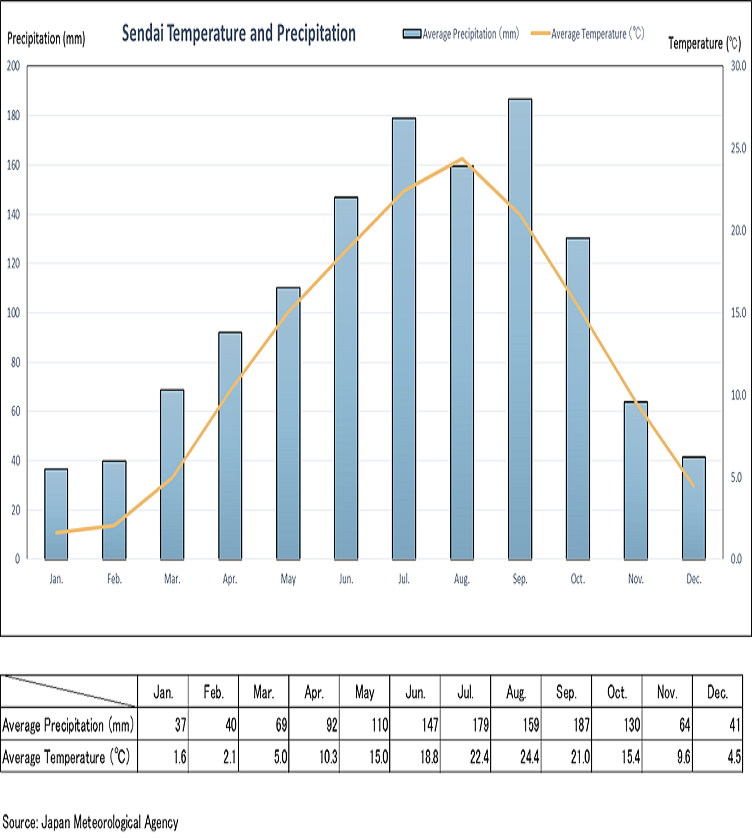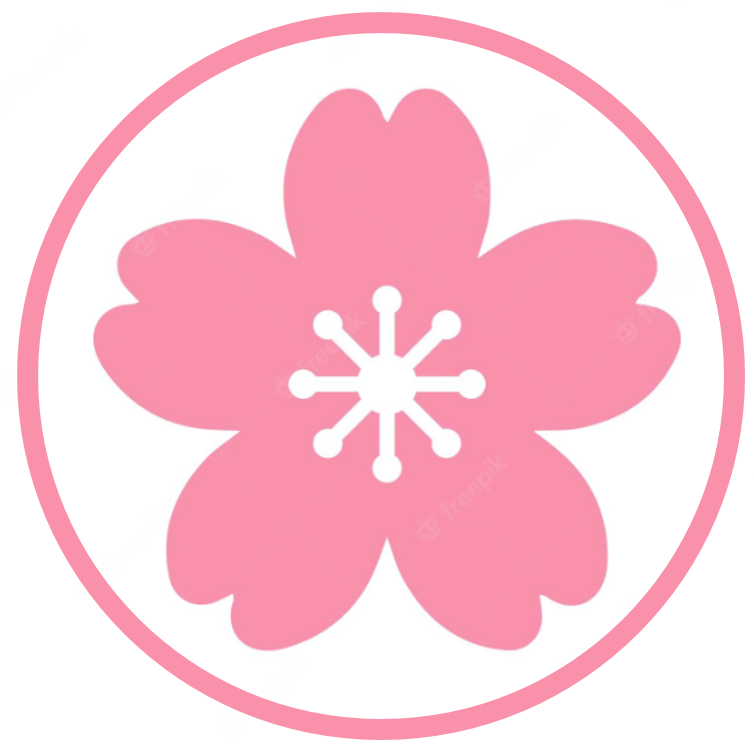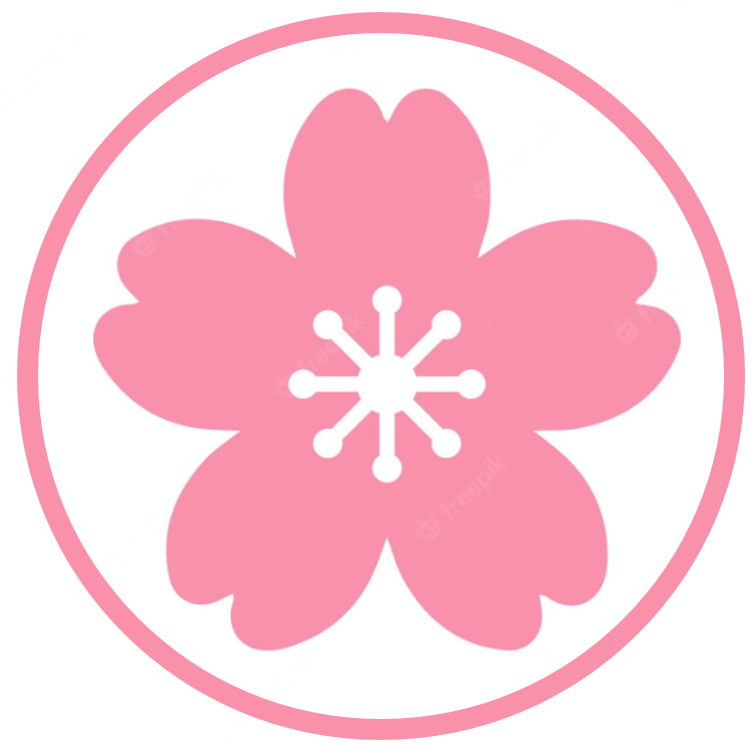Temperature
In Japan, Celsius is used to represent temperature.
| °C: Celsius | °F : Fahrenheit |
|---|---|
| 0 | 32 |
| 10 | 50 |
| 20 | 68 |
| 30 | 86 |
| 40 | 104 |
| 50 | 122 |
| 60 | 140 |
| 70 | 158 |
| 80 | 176 |
| 90 | 194 |
| 100 | 212 |
Conversion Calculator
°C→°F 1.8 x°C +32=°F °F →°C (°F – 32)x 0.555=℃
Climate, temperature and precipitation

Although Japan is a country with four distinct seasons, Sendai (and the wider “northeast” region of Tohoku) has relatively short summers and colder winters. With summer highs averaging 27℃, the city seldom becomes as hot and humid as Tokyo. The winter carries an average temperature of 1.5℃, with many sunny days and little snow.
There is also a rainy season that lasts from June to July, so students planning to come to school by foot or bicycle will need raincoats and waterproof footwear. All students should have warm winter clothes, such as hats, gloves etc. Furthermore, as buildings tend to be quite drafty and usually lack central heating, it can be surprisingly cold inside as well as outside during the winter. Therefore, students will need some sort of indoor heat source, such as a heated carpet or space-heater at their accommodations.
In short, students should bring clothing suited to seasonal weather variations, and they should be particularly well-prepared for the winter cold. Finally, appropriate attire should be brought for special occasions, such as the entrance and graduation ceremonies. On such occasions, many international students wear traditional clothing from their home countries.
| June (rainy season) | July-August (summer season) | January-February (winter season) | September (typhoon season) | |
|---|---|---|---|---|
| Average high temperature | 22°C | 27°C | 5°C | 24°C |
| Average low temperature | 16°C | 21°C | -1°C | 19°C |
| Average precipitation | 140mm | 165mm | 45mm | 220mm |
What to Wear
The below is a reference on what to wear in Sendai throughout the season:
Spring

(March-May)
Top
- Long sleeve shirt
- Fleece jacket
- Cardigan
- Sweater
- Duffle jacket
- Trench coat
Bottom
- Denim/Corduroy pants
- Woolen skirt
- Thick tights
Summer

(June-August)
Top
- Short sleeve T-shirt
- Linen blouses
- Cotton shirt
- Loose top
- Light cardigan
- Raincoat
Bottom
- Denim/Cotton/Linen pants
- Light skirt/dresses
- Waterproof shoes / rain boots (*during rainy season)
Autumn

(September-November)
Top
- Long sleeve shirt
- Fleece jacket
- Cardigan
- Sweater
- Duffle jacket
- Trench coat
Bottom
- Denim/Corduroy pants
- Woolen skirt
- Thick tights
Winter

(December-February)
Top
- Warm innerwear
- Woolen sweater
- Flannel long sleeve shirt
- Thick windproof winter coat
- Hat, scarf, gloves
Bottom
- Denim/Corduroy pants
- Woolen skirt
- Thick tights
- Boots (*especially during snowy weather)
Seasonal Precaution
Four season climates come with its own seasonal challenges.
Here we introduce the challenges that you may face during each seasons, and the measures that can be taken to combat the issues.


Spring and Autumn
Hay Fever / Kafunsho
Pollen allergies is quite common in spring and autumn in Sendai. The release of pollen in the air causes allergic reaction such as sneezing, runny nose, nasal congestion, eye irritation.
Those who are sensitive to pollen will find this extremely uncomfortable to a point that it may interfere with their daily activities.
Measure to take :
Wear mask when going outside, and purchase antihistamines from the pharmacy to aleviate allergy symptoms.

Summer
Heat Exhaustion and Heatstroke
Heatstroke, caused by overheating of the body is getting more common in Summer, and in extreme cases, it may lead to fatality.
Symptoms of heat exhaustion includes tiredness, dizziness, headache
nausea, cramps in the arms, legs and stomach, fast breathing or heartbeat and unconsciousness.
Measure to take :
Constantly hydrate, stay in the shades and out of the heat, use a heat deflecting umbrella when going out, wear loose and breathable material, use ice packs to cool down.
Indoor Mold
During Japan’s rainy season, moisture build up in your home may cause mold issues in your home which may affect your health.
Other than causing health issues, mold may also leave a permanent stain on walls and ceilings, and you may have to cover for this damages.
Measure to take :
Ventilate your home well, use dehumidifier, wipe down condensation immediately, use moisture absorber products in damp areas in your home.
Food Poisoning
Due to high temperatures and humidity during the summer months, food poisoning caused by bacterial growth on food is quite common in summer.
Measure to take :
Eat your food immediately or store them well, cook your meat thoroughly, wash you hands properly

Winter
Icy / Slippery Road
The roads in Sendai can get slippery in winter as roads can ice over if the temperature drops below 0 degrees celcius.
During this time, be extra cautious as you may slip on the icy road and injure yourself. Road accidents increases in winter due to slippery road as well.
Measure to take :
Wear non-slip shoes, refrain from riding on bicycles, and be cautious while walking. Those who drive a car or ride a motorcycle need to exchange their tyres for winter tyres or attach chains onto the wheels.
Influenza
According to Japan’s Ministry of Health Labour and Welfare, influenza circulation occurs annually, and infection peaks between December and March.
Measure to take :
Get the annual flu shot, maintain good hygiene, eat well balanced diet and get proper rest.
Tohoku University allows their faculty members to take a special leave (not taken out of their annual leaves) to get the annual flu shot.
Frozen Water Pipes
When the temperature falls below freezing point, the water inside piping may freeze and affect the water supply in your home, and even cause pipe burst in extreme cases.
Measure to take :
Drain the water inside the piping if you plan on being away for more than 2-3 days, or if the weather advisory advices you to do so. Ask your landlords or the management office for the location of water drainer and follow their intstruction to drain the water inside the piping. Insulate water pipe if necessary.
Refer to the below for further details:
- Sendai Waterworks Bureau Pamphlet (pdf) (*only in Japanese)
- Video(*only in Japanese):
Condensation
Condensation is very common in winter due to the humidity and the difference in indoor and outdoor temperature.
If left unattended, it can lead to indoor mold issues.
Measure to take :
Wipe off condensation immediately, and use condensation prevention sheet and spray available in the market. Ensure proper ventilation at home.
